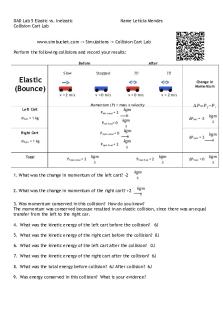PWV 03 Cart on a Ramp - Cart on a Ramp lab PDF

| Title | PWV 03 Cart on a Ramp - Cart on a Ramp lab |
|---|---|
| Course | Physics |
| Institution | Miami Dade College |
| Pages | 4 |
| File Size | 227.3 KB |
| File Type | |
| Total Downloads | 4 |
| Total Views | 121 |
Summary
Cart on a Ramp lab...
Description
Graphical Analysis 3
Cart on a Ramp (Sensor Cart) This experiment uses an incline and a low-friction cart. If you give the cart a gentle push up the incline, the cart will roll upward, slow and stop, and then roll back down, speeding up. A graph of its velocity vs. time would show these changes. Is there a mathematical pattern to the changes in velocity? What is the accompanying pattern to the position vs. time graph? What does the acceleration vs. time graph look like? Is the acceleration constant? In this experiment, you will use a Sensor Cart to collect position, velocity, and acceleration data for a cart rolling up and down an incline. Analysis of the graphs of this motion will answer the questions above.
Figure 1
OBJECTIVES
Collect position, velocity, and acceleration data as a cart rolls freely up and down an incline. Analyze position vs. time, velocity vs. time, and acceleration vs. time graphs. Determine the best fit equations for the position vs. time and velocity vs. time graphs. Determine the mean acceleration from the acceleration vs. time graph.
MATERIALS Chromebook, computer, or mobile device Graphical Analysis 4 app Go Direct Sensor Cart Vernier Dynamics Track Adjustable End Stop
PRELIMINARY QUESTIONS Physics with Vernier
© Vernier Software & Technology
1
Cart on a Ramp (Sensor Cart) Assuming the following data
Position Velocity Acceleratio n
Time 0 1 2 3 4 5 6 7 8 9 10 11 12 0.0 0.0 0.5 0.9 1.2 1.4 1.5 1.4 1.2 0.9 0.5 0.0 0.0 0.0 0.0 1.0 0.8 0.6 0.3 0.0 -0.2 -0.4 -0.6 -0.8 0.0 0.0 0.0 0.0 1.5 1.2 0.8 0.4 0.0 -0.5 -0.5 -0.5 -0.5 0.0 0.0
1. Consider the changes in motion that a cart will undergo as it rolls up and down an incline. Make a sketch of your prediction for the position vs. time graph. Describe in words what this graph means.
1.6 1.4
Position (m)
1.2 1 0.8 position
0.6 0.4 0.2 0
0
1
2
3
4
5
6
7
8
9
10
11
12
Time (S)
At the beginning the cart is at position zero, the cart is being pushed and it is rolling up and stop at the highest point. Then it starts rolling down back to starting point. 2. Make a sketch of your prediction for the velocity vs. time graph. Describe in words what this graph means.
2
Physics with Vernier
Cart on a Ramp (Sensor Cart) 1.5
Velocity (m/s)
1
0.5
0
Velocity 0
1
2
3
4
5
6
7
8
9
10
11
12
-0.5
-1
Time (S)
From this graph we can see at the beginning the cart has zero velocity, and at second 1 the cart is being pushed. The highest velocity is when the cart been pushed, and its velocity is been reducing when rolling up to the highest point and it stop, and the velocity is zero. It starts rolling down back to starting point with a negative velocity, and it stop when reached to starting point, the velocity is zero.
3. Make a sketch of your prediction for the acceleration vs. time graph. Describe in words what this graph means. 2.0
acceleratiom (m/s2)
1.5 1.0 0.5 Acceleration 0.0
0
1
2
3
4
5
6
7
8
9
10
11
12
-0.5 -1.0
Time (S)
Physics with Vernier
3
Cart on a Ramp (Sensor Cart) From this graph we can see at the beginning the cart has zero acceleration, and at second 1 the cart is being pushed. The highest acceleration is when the cart been pushed, and its acceleration is been reducing when rolling up to the highest point and it stop, and the velocity is zero. It starts rolling down back to starting point with a negative acceleration, and it stop when reached to starting point, the acceleration is zero.
4
Physics with Vernier...
Similar Free PDFs

Lab 1: Cart On A Ramp
- 8 Pages

PHET Ramp (Complete) - Lab
- 5 Pages

Ramp-Friction Lab completed
- 3 Pages

Stud On - 03 Heimatkunde a
- 5 Pages

Ramp-Up Guide Cloud Practitioner
- 4 Pages

Bail Application Flow Cart
- 1 Pages

Legion cart fake - Google Search
- 1 Pages

Fan Cart Physics SE (Disha
- 5 Pages

Week 5 Homework Crash Cart Drugs
- 2 Pages

Visión Cart Caso 2 Admon I
- 5 Pages
Popular Institutions
- Tinajero National High School - Annex
- Politeknik Caltex Riau
- Yokohama City University
- SGT University
- University of Al-Qadisiyah
- Divine Word College of Vigan
- Techniek College Rotterdam
- Universidade de Santiago
- Universiti Teknologi MARA Cawangan Johor Kampus Pasir Gudang
- Poltekkes Kemenkes Yogyakarta
- Baguio City National High School
- Colegio san marcos
- preparatoria uno
- Centro de Bachillerato Tecnológico Industrial y de Servicios No. 107
- Dalian Maritime University
- Quang Trung Secondary School
- Colegio Tecnológico en Informática
- Corporación Regional de Educación Superior
- Grupo CEDVA
- Dar Al Uloom University
- Centro de Estudios Preuniversitarios de la Universidad Nacional de Ingeniería
- 上智大学
- Aakash International School, Nuna Majara
- San Felipe Neri Catholic School
- Kang Chiao International School - New Taipei City
- Misamis Occidental National High School
- Institución Educativa Escuela Normal Juan Ladrilleros
- Kolehiyo ng Pantukan
- Batanes State College
- Instituto Continental
- Sekolah Menengah Kejuruan Kesehatan Kaltara (Tarakan)
- Colegio de La Inmaculada Concepcion - Cebu





